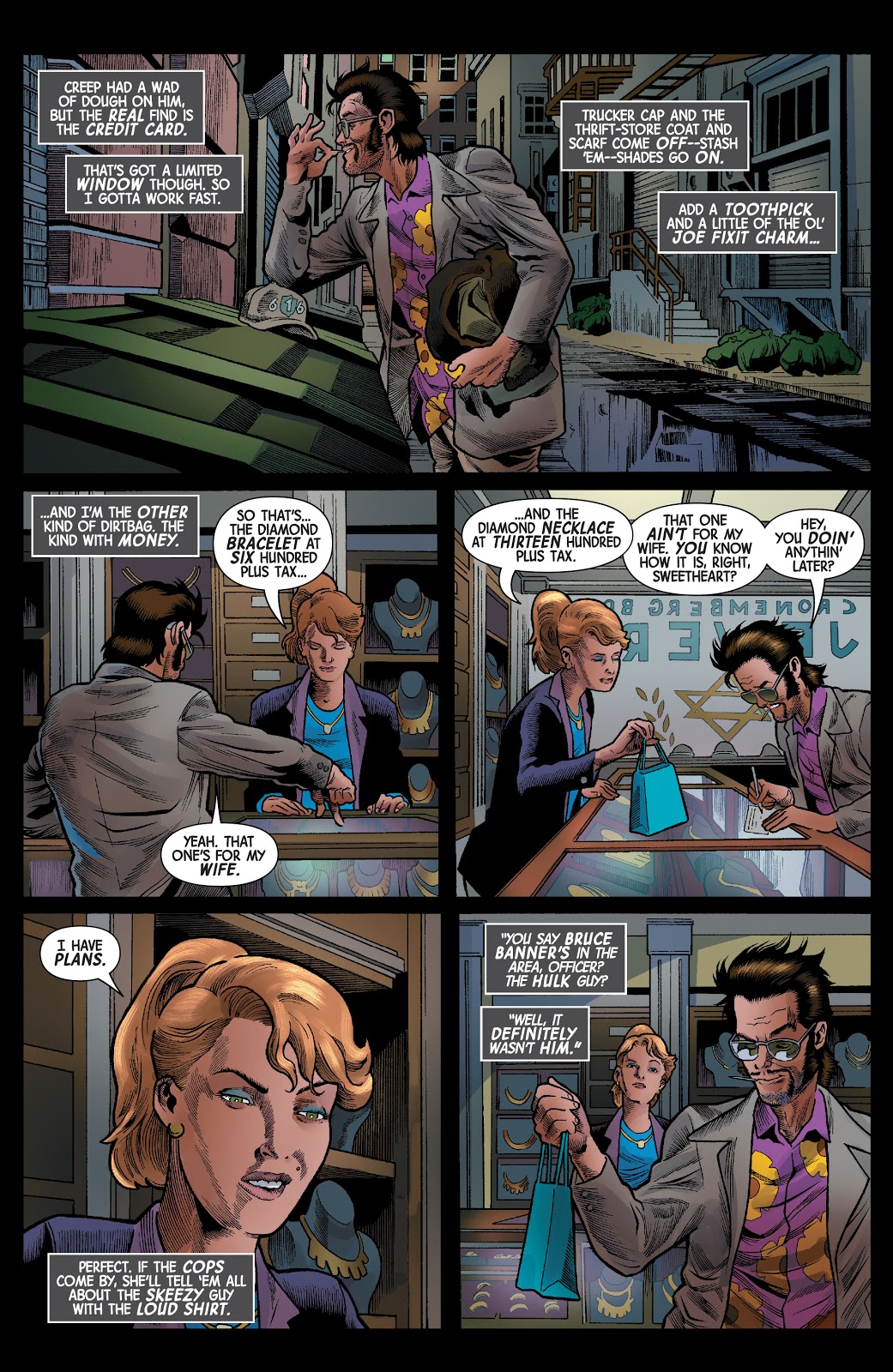In Marvel’s Immortal Hulk #43 — out this week from writer Al Ewing and artist Joe Bennett — there is a scene in which Bruce Banner, as a very human-looking version of his Joe Fixit Hulk persona, attempts to make some quick cash and throw people off his tail by pulling off a scam. Small as the scene is, it quickly drew criticism following the comics’ launch because of imagery Bennett incorporated into the background.
As part of Joe’s scheme to get his hands on money while evading the authorities, he sets out to pickpocket a rich man on the street, and proceeds to use the contents of his wallet to buy a number of expensive pieces of jewellery. He then takes that to a pawnshop in order to exchange it for cash — less than “he” paid for it, but more untraceable money than he began with. The entire sequence unfolds quickly at the top of the Marvel Comics issue and has little bearing on the book’s plot, but what gave many people pause was one panel in which the Star of David is prominently featured as part of the store allegedly meant to be called “Cronenberg’s Jewellery” window dressing.
[referenced id=”1664802″ url=”https://gizmodo.com.au/2021/01/jack-kirbys-son-to-insurrectionists-your-nazi-arse-captain-america-merch-sucks/” thumb=”https://gizmodo.com.au/wp-content/uploads/2021/01/15/i8t6tpmcju6vdezvgagl-300×169.png” title=”Jack Kirby’s Son to Insurrectionists: Your Nazi-Arse Captain America Merch Sucks” excerpt=”Captain America is, famously, a comic book character not too keen on far-right violence.”]
In addition to the Star of David, the positioning of both Fixit and the store employee in the panel block the store name in such a way that the letters visible spell out the word “Jewer,” something that, given both the imagery and the panel’s overall context, understandably led to some accusing Bennett of anti-Semitism. Between the absence of an “L” at all in “jewellery,” the Star of David, and the fact that this chunk of the story focuses on Fixit scamming his way into money, even if this was meant to be the creative team’s bad attempt at nodding to Uncut Gems, the optics alone in Immortal Hulk #43 make it more than easy to see why Bennett’s panels were offensive.

In response to the initial wave of backlash, Bennett took to his Facebook page with a statement explaining that the panel was meant to be a nod to director David Cronenberg, and because he illustrated the letters backward, he somehow ended up misspelling both the director’s name and “jewellery.”
“I have no excuse for how I depicted the Star of David,” Bennett wrote. “I failed to understand this troubling and offensive stereotype, and after listening to you all, I now understand my mistake.”
In addition to acknowledging that his drawing offended people, Bennett said that he and Marvel were taking steps to address the issue, though it’s unclear whether whatever action taking place is about this specific incident or the fact that it happened at all. “This is a mistake I must own, and I am sorry to everyone who I hurt by this,” Bennett wrote. “I am working with Marvel to correct this, and I am using this lesson to reflect on how I approach my stories and my work.”
[referenced id=”1110495″ url=”https://gizmodo.com.au/2018/06/marvels-editor-in-chief-really-wishes-we-could-all-just-forget-him-pretending-to-be-japanese/” thumb=”https://gizmodo.com.au/wp-content/uploads/2018/06/03/h4zdxl7ss2dd926xruiy-300×167.png” title=”Marvel’s Editor-In-Chief Really Wishes We Could All Just Forget Him Pretending To Be Japanese” excerpt=”Before he became Marvel’s newest Editor-In-Chief, C.B. Cebulski, a white man, spent months writing as “Akira Yoshida” in order to circumvent Marvel’s company policy that barred staff employees from working in editorial.”]
While Marvel has circulated Bennett’s statement to various outlets, when we reached out to the company asking more specifically what its plans are to address the issue — outside of editing the panel in the digital edition and future reprints — a representative explained that, internally, Marvel’s recognised and accepted its share of responsibility for the error in publishing Immortal Hulk #43 as-is. Though again, it’s unclear what the company’s move for the future will be to prevent this from occurring again.
Bennett’s illustration comes at a time when Marvel’s most high profile Jewish heroine, Kate Pryde, has been elevated to a new level of prominence within the publisher’s books following her new role established in Gerry Duggan, Matteo Lolli, Federico Blee, Cory Petit, and Tom Muller’s Marauders #1. In addition to adopting a new pirate getup befitting of a ship’s captain, Kate’s newest design features her wearing a simple necklace featuring a Star of David, a small but significant reminder of her Jewish heritage, which has often been downplayed across her various depictions.
Kate’s necklace was conspicuously missing from this week’s King In Black: Marauders one-shot from writer Gerry Duggan, artist Lue Ross, and colorist Carlos Lopez, but that isn’t nearly as questionable as what took place in Immortal Hulk #43. It’s easy to see, though, how both comics have become part of Marvel’s larger history of putting out work that raises questioning about creators’ intent.
Bennett’s case bears a number of similarities to the controversy that bubbled up around the first issue of Marvel’s short-lived X-Men: Gold which was illustrated by Ardian Syaf. The issue featured two visual references to the November 2016 Jakarta protests against governor Basuki Tjahaja that led to Marvel firing Syaf after people pointed out the anti-Semitic and anti-Christian meaning behind them. In the same way that Marvel pulled the panels in question from X-Men #1’s digital issue, the company’s done the same for Immortal Hulk #43, but none of that does anything to address the reality that both comics made it all the way to print after multiple revisions.
It is very hard to believe that, at a comics publisher that’s run by a white man most famous for pretending to be Japanese, things like this come across people’s desks during the production process and the bright red flags go completely unnoticed. What’s easy, but disappointing to believe is that this sort of thing has happened before, and it’ll likely happen again, especially if comics publishers don’t put in more stringent steps to stop it.
